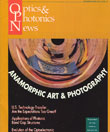
November 1992 Issue
Feature Articles
U.S. Technology Transfer: Are The Expectations Too Great?
Although technology transfer has always existed in the form of person-to-person communication, student matriculation, and publishing in professional journals, the process hit the national scene in the 1980s when congressional legislators sought out new ways to stop the perceived U.S. tumble in global competitiveness. Congress put technology transfer on the federal agenda with a series of laws aimed at attracting industry to joint partnerships with the federal laboratories.
by Susan M. ReissApplications Of Photonic Band Gap Structures
Imagine a material that would exclude all electromagnetic radiation in 4π steradians over a range of frequencies. The center frequency of the exclusion gap could be determined by the experimenter to be anywhere from the optical to the microwave region. The width of the gap would be large, at least 20% of the center frequency. Radiation outside that gap would be transmitted through the material, while radiation in the gap would be reflected. In-gap radiation generated inside the material would be trapped. Uses for such a material would be manifold, from filtering and noise suppression to modification of the electromagnetic vacuum and suppression of spontaneous emission. Such a material has recently been created: the photonic band gap crystal.
by Henry O. EverittNist And Metrology Standards
The Precision Engineering Division of NIST sponsored a workshop in mid-August to get input from U.S. industry on how NIST could more fully support industry's metrology needs. From the invitation, the workshop's goal was to "...help identify specific needs within U.S. manufacturing industries...for measurements and standards support from NIST which is not currently being provided at all or is being provided in forms or with accuracies insufficient to those needs."
by Robert E. ParksRevisiting Columbus At 500... What If?
On the occasion of the Columbus Quincentennial, it is interesting to speculate on how simple optical observations, or the lack thereof, may have had a major impact on the course of world history. Standing on a pier overlooking Mobile Bay one night, we noticed a phenomenon illustrated in Figure 1. As the head of the observer descends, it reaches a height x above the water at which a string of causeway lights across the bay suddenly disappear. These lights, whose height above the water is y, drop below the horizon due to the earth's radius of curvature, R.
by Bill GardnerAnamorphic Art and Photography Deliberate Distortions That Can Be Easily Undone
The distorted images you see on the cover and back page of this issue and throughout this article illustrate several fascinating phenomena in both art and geometrical optics. They are examples of anamorphic art and photography. Such artwork is distorted beyond recognition, but this distortion can be undone by simple means. Anamorphic art has a long history, many applications, and can form the basis of projects in courses in elementary optics, photography, art, psychology and computer science.
by David Stork

![A multiplexed image of a human tonsil acquired. [NIAID] using the iterative bleaching extends multiplexity (IBEX) method.](https://opnmedia.blob.core.windows.net/$web/opn/media/images/articles/2024/0424/departments/202404-cover-web.jpg?ext=.jpg)
